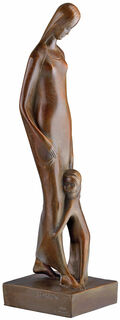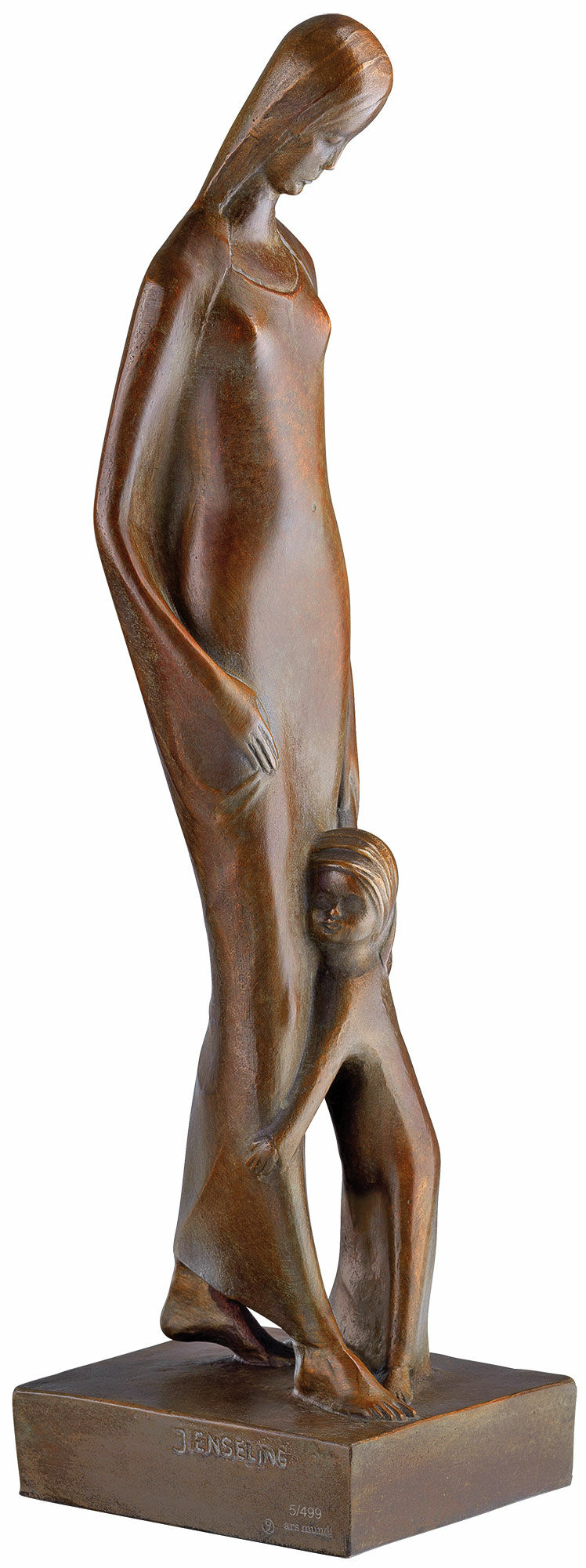Sculpture "Madonna with Child" (1920), reduction in bronze
Sculpture "Madonna with Child" (1920), reduction in bronze
Quick info
ars mundi Exclusive Edition | limited, 499 copies | numbered | signature | foundry hallmark | certificate | bronze | patinated | reduction | size 32 x 8.5 x 9.5 cm (h/w/d) | weight 2.8 kg
Detailed description
Sculpture "Madonna with Child" (1920), reduction in bronze
Original: Wood sculpture, stained reddish-brown, original size 87.5 x 22.5 x 26 cm. Privately owned.
Edition in bronze. Directly cast from the original and reduced in size (reduction), cast by hand using the Lost-Wax-Process and patinated brown. Limited edition of 499 copies, numbered and with the signature taken from the original as well as the foundry hallmark. ars mundi Exclusive Edition, published in cooperation with the community of joint-heirs. With numbered certificate of authenticity and limitation. Size 32 x 8,. x 9.5 cm (h/w/d). Weight 2.8 kg.
About Joseph Enseling
1886-1957, sculptor, mediator, teacher
He was the student of great teachers and the teacher of great students: Joseph Enseling.
The sculptor studied at the School of Arts and Crafts or School of Applied Arts in Düsseldorf, Germany. His students deserve mention as well and Joseph Beuys stands out among them as an innovator of art.
Enseling's training and his more than 40 years of teaching at what was to become the Folkwangschule Essen and the Kunstakademie Düsseldorf make the artist, who died in 1957, a great mediator between modernism and contemporary art, or even the interface of sculptural art in the 20th century. Enseling created a significant body of his work in all these years. Mostly he did it on commission, whether for private clients, in an (industrial) architectural context or for a monument.
His human figures are particularly expressive. To this day, they have an effect precisely because they are not intended to be merely academic studies of the body but show modern man as an active person who comes to terms with his world. Many of his works were installed in industrial areas on the Rhine and Ruhr. Enseling's insistence on contemporary reality is also clearly evident in his "Madonna" from 1920.
An alloy of copper with other metals (especially with tin) used since ancient times.
When casting bronze, the artist usually applies the lost-wax technique which is dating back more than 5000 years. It's the best, but also the most complex method of producing sculptures.
First, the artist forms a model of his sculpture. It is embedded in a liquid silicone rubber mass. Once the material has solidified, the model is cut out. The liquid wax is poured into the negative mould. After cooling down, the wax cast is removed from the mould, provided with sprues and dipped into ceramic mass. The ceramic mass is hardened in a kiln, whereby the wax flows out (lost mould).
Now we finally have the negative form, into which the 1400° C hot molten bronze is poured. After the bronze had cooled down, the ceramic shell is broken off and the sculpture is revealed.
Now the sprues are removed, the surfaces are polished, patinated and numbered by the artist himself or, to his specifications, by a specialist. Thus, each casting becomes an original work.
For lower-quality bronze castings, the sand casting method is often used which, however, does not achieve the results of a more complex lost-wax technique in terms of surface characteristics and quality.
Graphic or sculpture edition that was initiated by ars mundi and is available only at ars mundi or at distribution partners licensed by ars mundi.
Term for an art object (sculpture, installation), which is produced in multiple copies in a limited and numbered edition according to the artist‘s will.
Artist's multiples have been called the most accessible and affordable art on the market.
A plastic work of sculptural art made of wood, stone, ivory, bronze or other metals.
While sculptures from wood, ivory or stone are made directly from the block of material, in bronze casting a working model is prepared at first. Usually, it is made of clay or other easily mouldable materials.
The prime time of sculpture after the Greek and Roman antiquity was the Renaissance. Impressionism gave a new impulse to the sculptural arts. Contemporary artists such as Jorg Immendorf, Andora, and Markus Lupertz also enriched sculptures with outstanding works.






